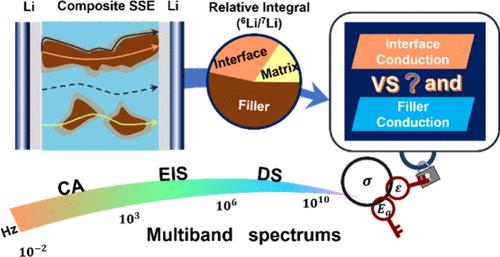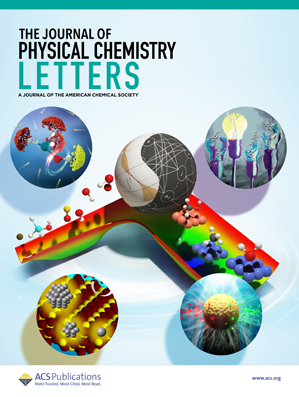Multiband Spectrum Method for Quantifying the Ionic Contribution of Volume Strategy and Filler Strategy: Enhancing the Ionic Transport Channels for Polymeric Solid-State Batteries
IF 4.8
2区 化学
Q2 CHEMISTRY, PHYSICAL
引用次数: 0
Abstract
As a promising solution for solid-state batteries with high energy density and safety, understanding the mechanism of fast ion conduction in polymer-ceramic composite solid-state electrolytes (CSEs) is still a challenging task. Herein, we understand the enhanced ion conduction in CSEs using a series of ionic spectra. Ionic insight is extended to ion conduction in CSEs, resolving the mechanism of fast ion migration. With the cooperation of enhanced interface and filler ion conduction, the CSE with a conductive filler exhibits ionic conductivity higher than that of CSEs with insulating fillers. Volume and filler strategies of CSE design are proposed based on volcanic maps of conductivity. An equivalent circuit is established to describe the conduction mechanism of CSEs. Specifically, Rinterface and Rfiller are in parallel to describe the cooperation of interface and filler conduction. They are in series with Rbulk, which represents a competition between the fundamental matrix and enhanced interface conduction. The proposed conduction model is verified though the energy storage performance of solid-state batteries; a fast dynamic process promises a better rate performance and cycling stability of solid-state batteries. These results provide deep insights into fast ion conduction in ceramic-polymer CSEs, which are indispensable to develop high-performance solid-state batteries.

量化体积策略和填充策略的离子贡献的多频谱方法:增强聚合物固态电池的离子传输通道
作为一种具有高能量密度和安全性的固态电池解决方案,了解聚合物陶瓷复合固态电解质(CSE)中的快速离子传导机制仍然是一项具有挑战性的任务。在此,我们利用一系列离子光谱来了解 CSE 中增强的离子传导。我们将对离子的洞察力扩展到了 CSE 中的离子传导,解决了离子快速迁移的机理。在界面和填料离子传导增强的共同作用下,含有导电填料的 CSE 比含有绝缘填料的 CSE 具有更高的离子传导性。根据电导率火山图,提出了 CSE 设计的体积和填料策略。建立了等效电路来描述 CSE 的传导机制。具体来说,Rinterface 和 Rfiller 并联以描述界面和填料传导的合作。它们与 Rbulk 串联,表示基本基质和增强界面传导之间的竞争。固态电池的储能性能验证了所提出的传导模型;快速动态过程保证了固态电池更好的速率性能和循环稳定性。这些结果深入揭示了陶瓷-聚合物 CSE 中的快速离子传导,对于开发高性能固态电池不可或缺。
本文章由计算机程序翻译,如有差异,请以英文原文为准。
求助全文
约1分钟内获得全文
求助全文
来源期刊

The Journal of Physical Chemistry Letters
CHEMISTRY, PHYSICAL-NANOSCIENCE & NANOTECHNOLOGY
CiteScore
9.60
自引率
7.00%
发文量
1519
审稿时长
1.6 months
期刊介绍:
The Journal of Physical Chemistry (JPC) Letters is devoted to reporting new and original experimental and theoretical basic research of interest to physical chemists, biophysical chemists, chemical physicists, physicists, material scientists, and engineers. An important criterion for acceptance is that the paper reports a significant scientific advance and/or physical insight such that rapid publication is essential. Two issues of JPC Letters are published each month.
 求助内容:
求助内容: 应助结果提醒方式:
应助结果提醒方式:


